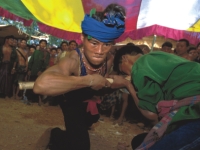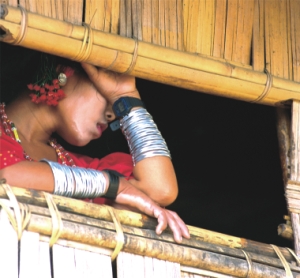|
Exhibition
A Plea for Survival
Hana Shams Ahmed
ACCORDING to researchers, the Mro (or Murung meaning 'new people') people settled in the forests of Bandarban in the 16th century after fleeing a clan war in the Arakan Hills. Now after five centuries, the greed of a group of Bangladeshi businessmen is putting the lives of a very colourful community at risk. Talented photographer Mahmud of Map photo agency spent a hundred days in Mro villages in Bandarban Sadar, Thanchi, Lama and Alikadam upazilas of Bandarban district in the Chittagong Hill Tracts (CHT) between 2001 and 2005 and captured the magnificence of the community's ordinary and not-so-ordinary lifestyle.
 The photo exhibition titled 'Ang ing mru rung' (meaning 'We are the new people') which is travelling all the way from Chittagong, Dhaka and Barisal to Jessore, Joypurhat and Sylhet is an ardent appeal for the community's right to live freely in their ancestral home. The Mro tribe is one of the several tribal groups that live in the CHT who are totally dependent on the forest for their livelihood. If these indigenous tribes are driven out of their territory, the botanical knowledge they possess will be lost forever. The photo exhibition titled 'Ang ing mru rung' (meaning 'We are the new people') which is travelling all the way from Chittagong, Dhaka and Barisal to Jessore, Joypurhat and Sylhet is an ardent appeal for the community's right to live freely in their ancestral home. The Mro tribe is one of the several tribal groups that live in the CHT who are totally dependent on the forest for their livelihood. If these indigenous tribes are driven out of their territory, the botanical knowledge they possess will be lost forever.
Like other hill people the Mros never thought that they needed government papers to own land. “The government in the 1980s sent people saying that they were the legal owners of the land,” says Mahmud about how the issue of land ownership came about. “The Bangalis asked them to show papers to prove their ownership when the bewildered  Mro people didn't even comprehend what connection a piece of paper had with their land. They have never been treated fairly by the government.” Mro people didn't even comprehend what connection a piece of paper had with their land. They have never been treated fairly by the government.”
The Mros have a very colourful culture that is completely alien to the majority Bangali communities. There is a complete role reversal in how men and women work in the families. Young men have to beautify themselves with flowers and silver jewellery to attract the attention of a suitable woman to marry. And no one is under any obligation to get married, they have the right to choose their bride or groom. Mro women do not get married until they are at least 18 years old as she has to be physically strong to take the responsibility of running the household. This includes such physically intense activities as carrying water, collecting firewood and pounding paddy. They also have to be strong enough to bear children. Men, who have fewer responsibilities, on the other hand can and usually do get married by 16. Photos of Mro young men ornately dressed in flowers and silver jewellery are exquisitely portrayed in Mahmud's photos.
The incredible thing is that while even many educated Bangalis are still suffering from the social evils of dowry, in Mro culture a bride has to be bought with the regular price of 110 silver coins (Tk 22,000 in 2006). The bride's mother is given the due respect for giving birth to her daughter and given 10 silver coins from that.
 A wedding is a very lavish affair in Mro culture. “And here too,” says Mahmud, “the Bangali money lenders don't hesitate to exploit the poor Mros.” Animals have to be sacrificed, and the whole community wined and dined. The money lenders take advantage of the Mro's ignorance to set their own unfair terms and conditions for lending money for wedding expenses. A wedding is a very lavish affair in Mro culture. “And here too,” says Mahmud, “the Bangali money lenders don't hesitate to exploit the poor Mros.” Animals have to be sacrificed, and the whole community wined and dined. The money lenders take advantage of the Mro's ignorance to set their own unfair terms and conditions for lending money for wedding expenses.
Unfortunately, lack of knowledge takes a huge toll on the lives of Mro babies. According to Mahmud a Mro woman will lose half her babies to malaria, cholera diarrhoea and other diseases before their fifth birthday. Many Mro people believe that illnesses result from angering the spirits. When a person falls ill his/her family takes the patient to the village sra (faith healer). The healing usually involves making animal sacrifices to pacify the spirits. They only ask for medicines as a last resort. “Unfortunately”, says Mahmud, “all the shops near to their village are controlled by the Bengalis. They keep all the out-of-date medicines for the indigenous people. So basically they are cheated from all sides.”
The role reversal continues in childcare. While the mother of the baby is out working, it is the father with help from the grandparents who look after the baby. According to an old Mro man, children are the reason they are alive and they are thought to be very important. Older children also help with the family chores and childcare.
The most colourful photographs is perhaps of those taken at the Mro's biggest festival the Chiashod Poi (the cow-killing ceremony). A big sacrificial ceremony takes place to celebrate the legend of the cow who had lied to God after eating up the alphabets and the religion of the Mros which was kept in its safe-keeping. The whole community gathers together in music and dancing surrounding the pierced tongue of a cow representing the dishonesty. Birth, death and marriage all calls for great rituals by the Mro people which is all very vividly represented in Mahmud's snapshots.

The main target age group for Mahmud's exhibition is the young generation and a far-reaching audience; and so it extended from Chittagong to Sylhet. “My idea is that people do not come to the exhibition. The exhibition goes to them! If I can just instil a certain amount of consciousness and respect in their heads maybe the situation will be better for the next generation.”
All Photo Credits: Mahmud/MAP Photo Agency/DANIDA/CIDA
Copyright (R) thedailystar.net 2006 |
